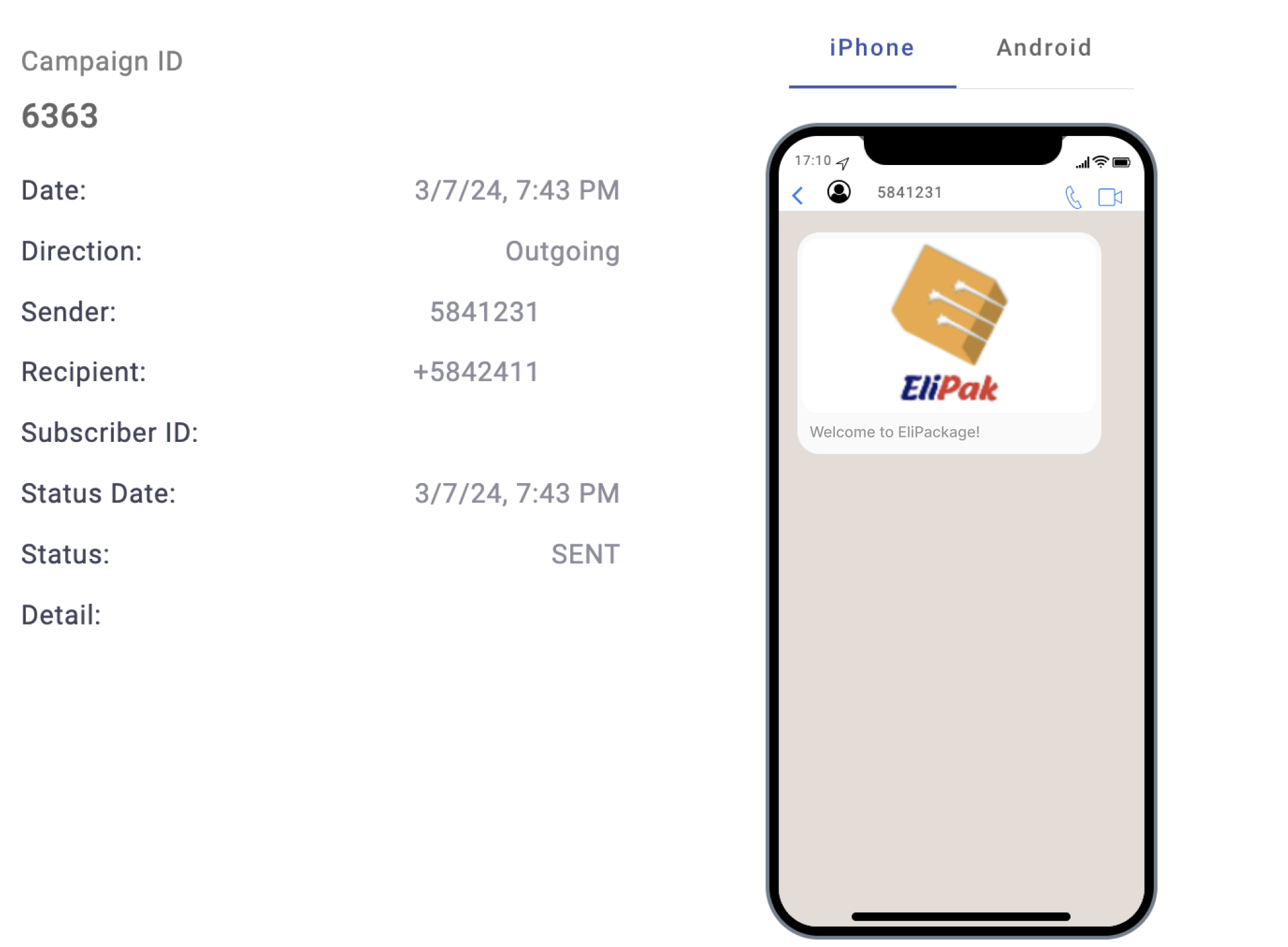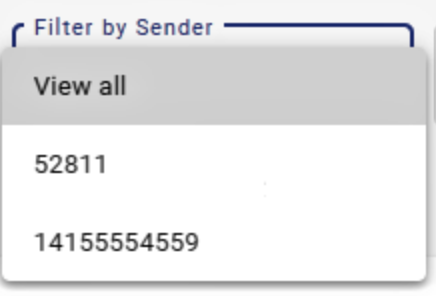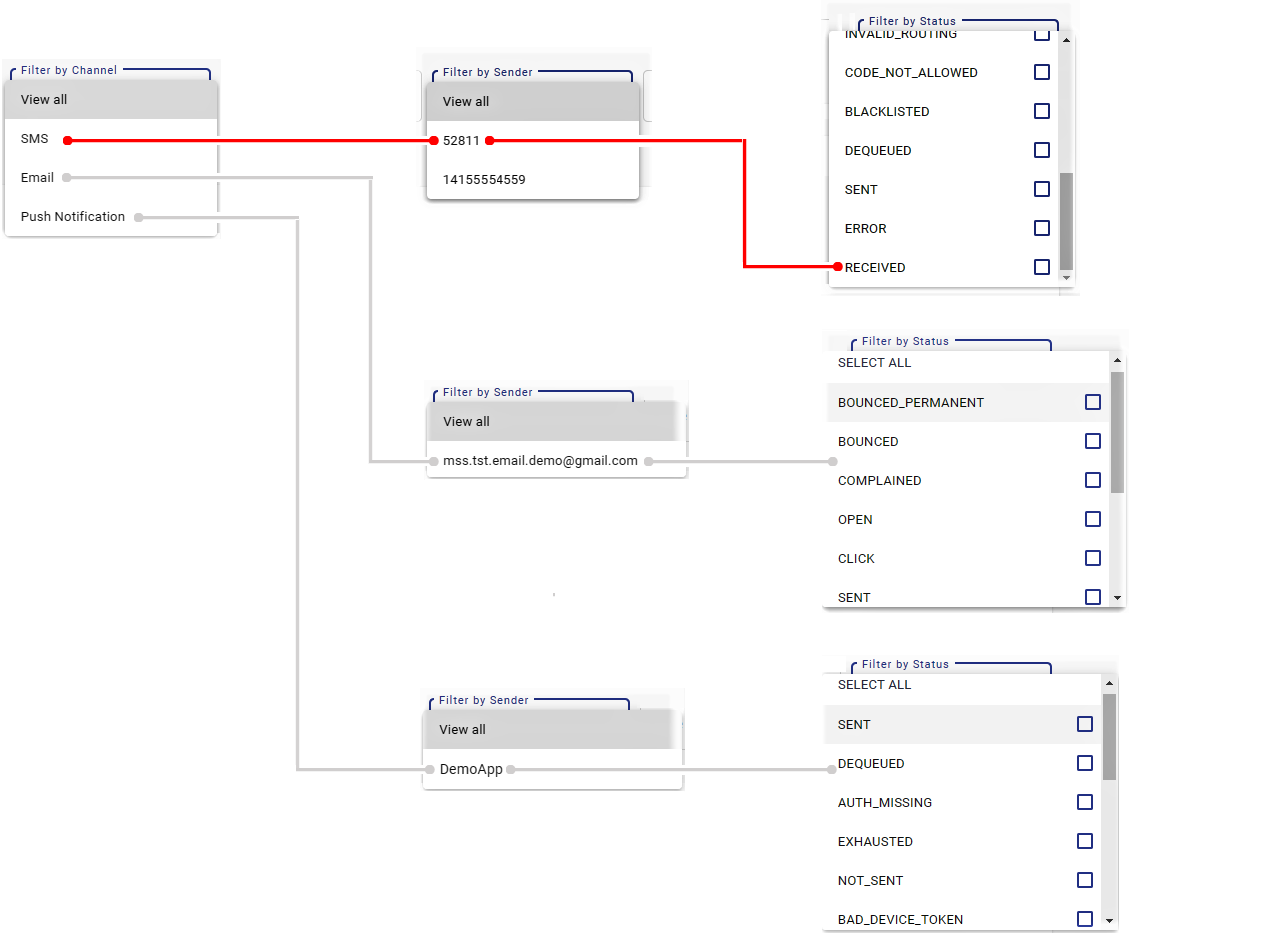Messaging Logs
At the bottom of the Messaging tab is a table with the messages related to the selected Date Range in the Show filter for the different delivery channels (SMS, Email, Push Notifications, RCS, WhatsApp).

In the table, the message records are arranged in reverse chronological order (newest to oldest), with 10 column headings, identifying the elements of the message record:
-
Date: date when the message took place.
-
Channel: either SMS, Email, Push Notification, RCS, or WhatsApp.
-
Direction: shows whether the message was outgoing or incoming.
-
Sender: identifies the platform "entity" that was involved in the exchange and the user, which is channel type dependent. For SMS and WhatsApp, it would be the sending or receiving number, for emails, the email address involved, for Push Notifications, the App involved, and for RCS, it would be the platform RBM identity or the user mobile phone number.
-
Recipient: entity who will receive the message.
-
Carrier: display the recipient's Mobile Operator for outgoing SMS messages, when available. Usually, carrier information will not be displayed during Status for Outbound Messages.
-
Status: represents the outcome of the exchange.
-
Status Date: when the status was recorded.
-
Campaign ID: identifies related messaging and interactive campaign IDs, and the alphanumeric identifier defined in the externalId field when API integrations are used to send messages.
-
Action: allows you to view in isolation the details of the particular entry of the table.
For WhatsApp, you can visualize the preview of outbound messages (MT), showing exactly how they will be seen by recipients. This preview also covers WhatsApp elements like Header types (Image, Video, Documents, text), Body, Footer, and Buttons types (Call to Action, Quick Reply) if they are part of the message.
For incoming WhatsApp messages (MO), you have the capability to preview multimedia content. This preview feature currently supports images, allowing you to see the image directly within the message interface preview. For other types of multimedia, such as voice messages, video, or documents, the preview is represented by an icon. Each icon is specific to the type of multimedia being received, helping to quickly identify the kind of content incoming.
NOTEFor incoming WhatsApp messages containing images , the preview of these multimedia files (images) will be visible for 3 days. After this period, the image preview will no longer be available, and only the icon representing an image file will be displayed.

| Row Name | Description |
|---|---|
| Campaign ID | Unique identifier of the campaign. |
| Date | Date when the message was sent. |
| Direction | Direction of the message: “Outgoing”: Mobile message routed from a client or an application and delivered to the end user’s mobile phone is called an MT (Mobile Terminated). “Incoming”: The term MO (mobile originated) message stands for a mobile message routed from an end user’s mobile device and delivered to a mobile phone or an application. |
| Sender | Sending identity (Sender) according to the delivery channel. |
| Recipient | Recipient's phone number or email address, according to the delivery channel the message was sent to. For SMS, WhatsApp, or RCS, it corresponds to the recipient's phone number. For Email, it corresponds to the recipient's email address. |
| Subscriber ID | Unique identifier of the subscriber. |
| Status Date | Date when the last update or status change. |
| Status | Status of the message. Each delivery channel has its message status. For more information to know the status message for each delivery channel, go to the Message Status section. |
| Detail | Reason (status description) why sending the WhatsApp and RCS message failed. If the message didn't fail when sending the message, the Detail will be blank. |
At the top of the table, and next to the log period detail (This Quarter Logs, for the sample screen shown), is the View all Logs access which takes you to a view of the Messaging log table that allows to modify its appearance in multiple ways to tailor it to your specific needs.
View all Logs
In the View all Logs section, the Message log table is replicated but with an added twist. The displayed contents can be modified through the use of three filters, Filter by Channel, by Sender and by Status, and a menu to select the columns to be displayed in the table, the Fields Visibility menu, that can be found at the top of the View all Logs section, as shown in the screenshot below.

You can filter each log according to the following items:
-
Date Range Filter: filter the logs according to the selected date range. Only data generated within the selected range in the Show filter will be displayed. When selecting the "This Week" option, the date range filter could consider Sunday as the first day of the week, depending on the browser's timezone.
-
Search by: You can search between the recipient or the unique identifier of the campaign (Campaign ID) by selecting the desired option (Recipient or Campaign ID) from the Search by dropdown menu.
-
Search textbox: Type the recipient or campaign ID according to the option selected from the Search by dropdown menu.
-
Filter by Channel: Select the desired delivery channel (SMS, RCS, Email, Push, WhatsApp) you want to filter by.
-
Filter by Sender: Click on the sender according to the option selected from the Filter by Channel dropdown menu.
-
Filter by Status: Click on the desired status or statuses according to the option selected from the Filter by Sender dropdown menu.
For more information to know the status message for each delivery channel, go to the Message Status section.
-
Fields Visibility: Allows users to choose which data fields are visible according to their needs or tasks at hand. That is, by clicking on the Fields Visibility dropdown menu, you can select or unselect which columns will be relevant to the table.
The best way to describe all options is to work it out through an example.
Starting from the hypothetical table shown below, let us go through the process of honing in on a particular message event by using the options available in this section.

Say that we wish to view all the SMS messages sent from the Sender 52811 (short code) with a Status of DELIVRD. The steps are as follows:
- Under the Filter by Channel, select SMS. This action will enable the two filters to its right, Filter by Sender and Filter by Status, which only become active once one of the delivery channels is selected.

- Since we are interested in the messages sent from 52811, from the Filter by Sender, we select it.

- Finally, we move over to Filter by Status and from the list of available states we select the RECEIVED state.

The end result will be the table that follows, which only includes SMS messages sent from 52811 with a state of RECEIVED as shown in the screenshot.

Once the table is modified to display the desired information, a report reflecting the modification can be obtained via an Email sent to the email account associated with the current session. This is done by clicking Export Report and only after it has been confirmed through the dialog box that follows.
Important to note is that the report is generated as a .csv file, as all the reports generated by the platform.
Once the Ok button is selected, immediately a confirmation message will display at the bottom of the screen mentioning that the report is being processed and it will take a certain time (in seconds) to be completed and sent directly to the mail. The confirmation message will disappear after a few seconds.
Depending on the total number of records, it will take a certain time to process each one of the records.

NOTEIf you export an Email report, the "Content" record will not be available in the CSV file.
From the process just described, it can be seen that there are multiple setting combinations, in a variety of contexts, with details covering potential scenarios that arise when delivering messages, and that in the example, it went through the path highlighted with the red trace, of many possible paths, depicted in the figure below.

To complement the example, here are the definitions of the role of each element found in the View all Logs section:
- Back: allows you to return to the main Messaging tab screen.
- Show: allows to pinpoint the specific date or date range of messages to be displayed.
- Export report: will trigger the generation of an email to be sent to the email address of the email associated with the session in progress, containing a report (.csv formatted file) based on the values selected for each filter and/or field selected.
- Fields Visibility: allows to selection of which columns will be displayed within the message log table. Default value: all selected.
- Filter by Channel: menu that allows you to choose the displayed information on the table based on the delivery Channel (SMS, Email, Push notification, WhatsApp, RCS). Default value: view all.
- Filter by Sender: This is a context-dependent menu that filters table information based on the sender and conditioned on the delivery Channel value above. This is to say, that if the Filter by Channel is set to SMS, this dropdown menu will display the Sending Number or route options programmed into the platform associated with SMS deliveries, if the Filter by Channel is set to Email, it will display the email(s) that are programmed into the platform, and if the Filter by Channel is set to Push, it will display de source App. Default value: view all.
- Filter by Status: This is another context-dependent menu that filters table information based on the state of messages, conditioned by the values in Filter by Channel and Filter by Sender. Each delivery channel has a different set of possible results that reflect the treatment that a message may have undergone throughout its life, with transient and/or final outcomes. Default value: view all.
INCOMING & OUTGOING FILTERIf you only want to get (filter) all messages that have been incoming, click on the 'RECEIVED' option (status) from the dropdown menu of the Filter by Status.
If you only want to get (filter) all messages that have been outgoing, click on the 'SELECT ALL' option from the dropdown menu of the Filter by Status and unselect the 'RECEIVED' option (status).
For the details of the possible message states and their descriptions, go to the Message Statuses section.
Updated 3 months ago
